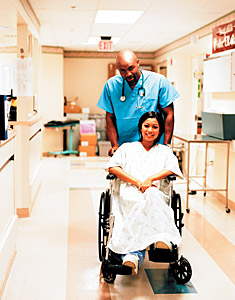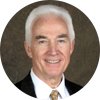Briefly tell us about yourself and how you decided to become a doctor of chiropractic. When I was a young child, I always had a penchant for talking to people in wheelchairs, wanting to touch them.
Throughout my youth, however, I was challenged in determining what discipline to pursue. My family had a bias toward the medical model, as my mom was an office assistant for a family doctor and my Dad has relatives in the medical professions. I recall hearing from him that chiropractors were quacks, so that [career avenue] was quickly crossed off my list. I entered UCLA to pursue a kinesiology degree, knowing that this education would prepare me for almost any medical program I wished to pursue.
Initially I thought PT would be the way to go, so I sent my application to a PT program in San Francisco and was accepted. I then volunteered at the UCLA medical center in the PT department and found they were mostly working with amputees. It was quickly obvious to me that the PTs were under doctors' orders and most of the patients were depressed, so I declined my acceptance at University of San Francisco. It was then I went on a rampage trying to figure out what to do. I knew I did not have the heart for surgery and I wanted to do more than write prescriptions, so traditional medicine was out. I went to massage school and 10 months later, graduated with a better understanding of the human body; but I was concerned about the sordid reputation the massage profession has had to struggle with throughout the years. I then entered acupressure school and became certified in jin shin do. While I found that to be fascinating, the outcomes seemed to be too slow and theoretical to me; I wanted to see and feel the effects of my work immediately.
 Then, through a stroke of providence, while walking down the streets of Santa Monica, crossing Sepulveda Blvd., a perfect stranger asked me if I wanted to see where he worked. We walked deliberately to his office and I observed him while he treated two patients, one with acute low back pain and another with a severe headache. I was so delighted to be introduced to a system of healing with a focus on hands-on care, taking care of acute pain, in a manner that produced immediate results. One week later I signed up for chiropractic college at the northern California campus that later became Palmer West Chiropractic College.
Then, through a stroke of providence, while walking down the streets of Santa Monica, crossing Sepulveda Blvd., a perfect stranger asked me if I wanted to see where he worked. We walked deliberately to his office and I observed him while he treated two patients, one with acute low back pain and another with a severe headache. I was so delighted to be introduced to a system of healing with a focus on hands-on care, taking care of acute pain, in a manner that produced immediate results. One week later I signed up for chiropractic college at the northern California campus that later became Palmer West Chiropractic College.
Describe how you became interested in occupational health and applied ergonomics. My first 25 years following licensure were focused on working with the medical community. After three years in private practice, I was able to break into an organization known as the Group Health Cooperative, where I treated patients in a HMO setting. Along with clinical care, I had an administrative role and grew the number of DCs working on a panel from one to over 90 in the eastern Washington region. It was then that I was given the opportunity to [either] do full administration for the entire state or leave this role and continue with clinical practice.
That decision was not difficult for me and I entered into full-time practice with my husband, Dr. Dana Weary. Over time, I learned that not only can you influence how patients get referred to chiropractors by networking with medical doctors, [but also] that the employer plays a huge role in the health care outcomes of their employees. At that time, I felt compelled to pursue my diplomate certification in occupational health and applied ergonomics, and began my course of study at Northwestern Health Sciences University, which was completed three years later.
I understand you are currently involved with an exciting project with one of the large medical facilities in your community. Briefly tell our readers about this opportunity and how it came about. While studying occupational health principles through Northwestern's training program, I was exposed to some amazing chiropractors who had created on-site clinics for injured workers within the industrial facility. It was then I realized that I wanted to set up an on-site clinic within a large industry to provide effective and timely care for injured workers.
I chose the largest hospital system in Spokane, as it has more than 4,000 employees. Nurses are notoriously challenged by lifting patients, who are becoming larger and heavier every year, so it seemed we would be caring for many challenging cases. Over the years I have developed a positive working relationship with many of the VPs of this hospital and treated several of them as well. Given my past relationship with a large medical group, it seemed a perfect fit to accomplish my required diplomate field-consulting project at this venue.
Please describe the major occupational health services you are providing via this relationship. At present, our chiropractic service is housed within a massage clinic that has been on-site for many years and treats a fair number of "well" employees. We established our clinic in the back and in addition to the provision of chiropractic care, we have recruited an occupational therapist and massage therapist doing structural integration, to assist with patient care three days each week. We also make suggestions on ergonomic improvement, but do not want to step on the toes of folks who have worked in that capacity for some time.
My initial goal is to show the decision-makers that we can save them money by caring for their injured workers. As this succeeds, we will begin the conversation of establishing a whole-person wellness center, as well as providing such services as post-offer, pre-placement physical screening exams and other highly effective occupational health services we have been trained in.
What have you found to be the greatest challenges or primary obstacles you have had to overcome in marketing your professional services within this group? The hardest thing is getting the word out. I have worked with the emergency department and created good working relationship with the doctors there so they are comfortable making referrals, but like with all new things, it takes time to change referral habits. It also takes time for an employee we have treated to influence their co-workers to experience our approach. Some of them may have had bad experiences with chiropractic in the past, or have been exposed to an age-old medical bias against our profession. To those concerns, I say just work hard, keep talking and be patient. If you are passionate about helping others, they will come.
What special training or preparation did you engage in to feel confident in approaching this client? In the distant past I had been criticized for working with the medical profession, especially about 20 years ago. Some of my colleagues suggested that I had sold out, but the truth be told, I always felt if you were reasonable and kind, that a competent DC could get beyond the resistance and work from the inside and make the biggest difference for our profession; in a sense, educating the MD from within.
I sort of laugh when I hear someone insinuate that I have sold out to the medical profession, as all along I [have been] treating their patients with chiropractic care, helping them to avoid medication and surgical procedures that weren't necessary. I say all of this to better answer this question. I think you need to have a personality that is flexible, reasonable and kind, while at the same time have a dogged determination regarding where you want to go and the place you want to arrive at.
Do you feel that providing occupational health and ergonomics services and assisting businesses and organizations with their health, wellness and safety programs has a bright future for appropriately trained doctors of chiropractic? Overwhelmingly so! I am so excited about what these types of clinics can do for our profession and ill and injured workers that I almost feel like I just started practice again! I am currently the committee chair for the ACA's Workers' Compensation Committee and we have great plans to help our doctors take these very same steps. Clearly, chiropractors need to be in this role, as we can help industries and their employees enjoy better bottom lines and healthier backs!
Do you have any other commentary you would like to add? Working with injured workers is obviously not everyone's cup of tea, as you have to be able to feel their concerns and fears, honor them and help them to come up with creative strategies to cope and find a way back to work. While many of my male colleagues do an amazing job in this arena, I feel that with the proper training and motivation this work lends itself to female chiropractors' perspectives as well. I am happy to answer questions or respond to e-mail at: .
Click here for previous articles by Joseph J. Sweere, DC, DABCO, DACBOH, FICC.





